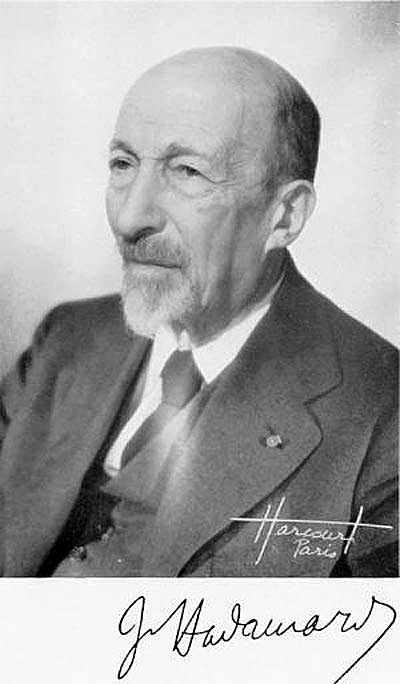.
Jacques Hadamard
Jacques Salomon Hadamard FRS[2] (8 December 1865 – 17 October 1963) was a French mathematician who made major contributions in number theory, complex function theory, differential geometry and partial differential equations.[3][4]

Jacques Hadamard
Biography
The son of a teacher, Amédée Hadamard, of Jewish descent, and Claire Marie Jeanne Picard, Hadamard attended the Lycée Charlemagne and Lycée Louis-le-Grand, where his father taught. In 1884 Hadamard entered the École Normale Supérieure, having been placed first in the entrance examinations both there and at the École Polytechnique. His teachers included Tannery, Hermite, Darboux, Appell, Goursat and Picard. He obtained his doctorate in 1892 and in the same year was awarded the Grand Prix des Sciences Mathématiques for his essay on the Riemann zeta function.
In 1892 Hadamard married Louise-Anna Trénel, also of Jewish descent, with whom he had three sons and two daughters. The following year he took up a lectureship in the University of Bordeaux, where he proved his celebrated inequality on determinants, which led to the discovery of Hadamard matrices when equality holds. In 1896 he made two important contributions: he proved the prime number theorem, using complex function theory (also proved independently by de la Vallée Poussin); and he was awarded the Bordin Prize of the French Academy of Sciences for his work on geodesics in the differential geometry of surfaces and dynamical systems. In the same year he was appointed Professor of Astronomy and Rational Mechanics in Bordeaux. His foundational work on geometry and symbolic dynamics continued in 1898 with the study of geodesics on surfaces of negative curvature. For his cumulative work, he was awarded the Prix Poncelet in 1898.
After the Dreyfus affair, which involved him personally because his wife was related to Dreyfus, Hadamard became politically active and a staunch supporter of Jewish causes[5] though he professed to be an atheist in his religion.[6]
In 1897 he moved back to Paris, holding positions in the Sorbonne and the Collège de France, where he was appointed Professor of Mechanics in 1909. In addition to this post, he was appointed to chairs of analysis at the École Polytechnique in 1912 and at the École Centrale in 1920, succeeding Jordan and Appell. In Paris Hadamard concentrated his interests on the problems of mathematical physics, in particular partial differential equations, the calculus of variations and the foundations of functional analysis. He introduced the idea of well-posed problem and the method of descent in the theory of partial differential equations, culminating in his seminal book on the subject, based on lectures given at Yale University in 1922. He was elected to the French Academy of Sciences in 1916, in succession to Poincaré, whose complete works he helped edit. Later in his life he wrote on probability theory and mathematical education. He was awarded the CNRS Gold medal for his lifetime achievements in 1956.
Hadamard's students included Maurice Fréchet, Paul Lévy, Szolem Mandelbrojt and André Weil.
On creativity
In his book Psychology of Invention in the Mathematical Field, Hadamard uses introspection to describe mathematical thought processes. In sharp contrast to authors who identify language and cognition, he describes his own mathematical thinking as largely wordless, often accompanied by mental images that represent the entire solution to a problem. He surveyed 100 of the leading physicists of the day (approximately 1900), asking them how they did their work.
Hadamard described the experiences of the mathematicians/theoretical physicists Carl Friedrich Gauss, Hermann von Helmholtz, Henri Poincaré and others as viewing entire solutions with “sudden spontaneousness”.[7]
Hadamard described the process as having four steps of the five-step Graham Wallas creative process model, with the first three also having been put forth by Helmholtz:[8] Preparation, Incubation, Illumination, and Verification.
See also
Cartan–Hadamard theorem
Cauchy–Hadamard theorem
Hadamard product:
entry-wise matrix multiplication
an infinite product expansion for the Riemann zeta function
Hadamard code
Hadamard's dynamical system
Hadamard's inequality
Hadamard's method of descent
Hadamard finite part integral
Hadamard manifold
Hadamard matrix
Hadamard's maximal determinant problem
Hadamard space
Hadamard three-circle theorem
Hadamard Transform
Hadamard–Rybczynski equation
Ostrowski–Hadamard gap theorem
References
^ Hadamard, J. (1942). "Emile Picard. 1856-1941". Obituary Notices of Fellows of the Royal Society 4 (11): 129–126. doi:10.1098/rsbm.1942.0012. edit
^ Cartwright, M. L. (1965). "Jacques Hadamard. 1865-1963". Biographical Memoirs of Fellows of the Royal Society 11: 75–26. doi:10.1098/rsbm.1965.0005. edit
^ O'Connor, John J.; Robertson, Edmund F., "Jacques Hadamard", MacTutor History of Mathematics archive, University of St Andrews.(or, see: this Webcite "backup" copy, archived from the original)
^ Jacques Hadamard at the Mathematics Genealogy Project
^ Hadamard, Jacques (1954). An essay on the psychology of invention in the mathematical field / by Jacques Hadamard. New York: Dover Publications. ISBN 0-486-20107-4.
^ Hadamard on Hermite
^ Hadamard, 1954, pp. 13-16.
^ Hadamard, 1954, p. 56.
Publications
Hadamard, Jacques (2003) [1923], Lectures on Cauchy's problem in linear partial differential equations, Dover Phoenix editions, Dover Publications, New York, ISBN 978-0-486-49549-1, JFM 49.0725.04, MR0051411
Hadamard, Jacques (1999) [1951], Non-Euclidean geometry in the theory of automorphic functions, History of Mathematics, 17, Providence, R.I.: American Mathematical Society, ISBN 978-0-8218-2030-8, MR1723250
Hadamard, Jacques (2008) [1947], Lessons in geometry. I, Providence, R.I.: American Mathematical Society, ISBN 978-0-8218-4367-3, MR2463454
Hadamard, Jacques (1968), Frechet, M.; Levy, P.; Mandelbrojt, S. et al., eds., Œuvres de Jacques Hadamard. Tomes I, II, III, IV, Éditions du Centre National de la Recherche Scientifique, Paris, MR0230598
Further reading
Maz'ya, Vladimir; Shaposhnikova, T. O. (1998), Life and Work of Jacques Hadamard, American Mathematical Society, ISBN 0-8218-0841-9.
Maz'ya, V. G.; Shaposhnikova, T. O. (1998), Jacques Hadamard: a universal mathematician, History of Mathematics, 14, American Mathematical Society/London Mathematical Society, ISBN 0821819232
Retrieved from "http://en.wikipedia.org/"
All text is available under the terms of the GNU Free Documentation License


